Application of UHPLC-ESI-MS/MS-Based Metabonomic Techniques to Analyze the Cordyceps cicadae Metabolic Profile Changes to the CO(NH2)2 Response Mechanism in the Process of Ergosterol Synthesis
Abstract
1. Introduction
2. Materials and Methods
2.1. Reagents
2.2. Microorganism and Culture Conditions
2.3. The Preparation of C. cicadae Samples
2.4. The Qualitative and Quantitative Determination of Ergosterol
2.5. UHPLC-ESI-MS/MS Analysis
2.6. Data Processing
2.7. Differential Metabolites Identification
3. Results
3.1. Effect of CO(NH2)2 on the Contents of Intracellular and Extracellular Ergosterol
3.2. Analysis of Mycelial Metabolites
4. Discussion
4.1. Carbohydrate
4.2. Protein and Nucleic Acid Metabolism
4.3. Lipid Metabolism
4.4. Hormones and Vitamins
4.5. Sterol
4.6. Other Secondary Metabolites
5. Conclusions
Author Contributions
Funding
Institutional Review Board Statement
Informed Consent Statement
Data Availability Statement
Conflicts of Interest
References
- Nxumalo, W.; Elateeq, A.A.; Sun, Y. Can Cordyceps cicadae be used as an alternative to Cordyceps militaris and Cordyceps sinensis?—A review. J. Ethnopharmacol. 2020, 257, e112879. [Google Scholar] [CrossRef] [PubMed]
- He, Y.Q.; Zhang, W.C.; Peng, F.; Lu, R.L.; Zhou, H.; Bao, G.H.; Wang, B.; Huang, B.; Li, Z.; He, L. Metabolomic variation in wild and cultured cordyceps and mycelia of Isaria cicadae. Biomed. Chromatogr. 2019, 33, e4487. [Google Scholar] [CrossRef] [PubMed]
- Wen, P.; Chen, S.D.; Zeng, B.; Liang, H.L.; Wang, T.; Bai, L.Y.; Tao, J.; Zhang, X.; Wang, J. Protective effect and mechanism of polysaccharides from Cordyceps cicadae on acute liver injury induced by D-GlaN in mice. MedPlant 2018, 9, 102–106. [Google Scholar]
- Liu, N.H.; Zhou, S.; Olatunji, O.J.; Wu, Y. Nucleosides rich extract from Cordyceps cicadae alleviated cisplatin-induced neurotoxicity in rats: A behavioral, biochemical and histopathological study. Arab. J. Chem. 2022, 15, 103476. [Google Scholar] [CrossRef]
- Shi, C.E.; Song, W.L.; Gao, J.; Yan, S.B.; Guo, C.; Zhang, T.F. Enhanced production of cordycepic acid from Cordyceps cicadae isolated from a wild environment. Braz. J. Microbiol. 2022, 53, 673–688. [Google Scholar] [CrossRef] [PubMed]
- Zhu, R.; Zheng, R.; Deng, Y.Y.; Chen, Y.P.; Zhang, S.W. Ergosterol peroxide from Cordyceps cicadae ameliorates TGF-β1-induced activation of kidney fibroblasts. Phytomedicine 2014, 21, 278–372. [Google Scholar] [CrossRef]
- Zheng, Y.; Li, S.Y.; Li, C.; Shao, Y.; Chen, A.H. Polysaccharides from spores of Cordyceps cicadae protect against cyclophosphamide-induced immunosuppression and oxidative stress in mice. Foods 2022, 11, 515. [Google Scholar] [CrossRef]
- Zheng, R.; Wang, Y.H.; Zhong, Y.F.; Zhu, R. The mushroom, Cordyceps cicadae, ameliorates renal interstitial fibrosis via TLR2-mediated pathways. Trop. J. Pharm. Res. 2020, 19, 2153–2159. [Google Scholar] [CrossRef]
- Wang, Y.N.; Zeng, T.T.; Li, H.; Wang, Y.D.; Wang, J.H.; Yuan, H.B. Structural characterization and hypoglycemic function of polysaccharides from Cordyceps cicadae. Molecule 2023, 28, e526. [Google Scholar] [CrossRef]
- Li, I.C.; Lin, S.; Tsai, Y.T.; Hsu, J.H.; Chen, Y.L.; Lin, W.H.; Chen, C.C. Cordyceps cicadae mycelia and its active compound HEA exert beneficial effects on blood glucose in type 2 diabetic db/db mice. J. Sci. Food Agric. 2019, 99, 606–612. (In Chinese) [Google Scholar] [CrossRef] [PubMed]
- Sun, Y.F.; Michael, W.; Wang, P.; Lu, H.; Zhao, H.; Liu, H.; Wang, S.; Sun, Y.; Liang, Z. Biological characteristics, bioactive components and antineoplastic properties of sporoderm-broken spores from wild Cordyceps cicadae. Phytomedicine 2017, 36, 217–228. [Google Scholar] [CrossRef]
- Feng, T.; Deng, W.Q.; Liu, J.K. Two highly conjugated ergosterols from the fungus Psathyrella rogueiana and their anti-inflammatory activity. J. Asian Nat. Prod. Res. 2023, 26, 52–58. [Google Scholar] [CrossRef] [PubMed]
- Dong, S.J.; Jiang, Y.L.; Peng, J.; Zhang, C.X.; Zhu, Q.; Wang, Q.Q.; Liao, Y.N.; Pi, W.L.; Dong, X.Y.; Yuan, J.P.; et al. Evaluation of ergosterol composition and esterification rate in fungi isolated from mangrove soil, long-term storage of broken spores, and two soils. Appl. Microbiol. Biotechnol. 2020, 104, 5461–5475. [Google Scholar] [CrossRef] [PubMed]
- Erica, M.; Sharon, R.; Gregory, J.S.; Gonzalez, T.; Abman, S.H.; Fleet, J.C. Maternal vitamin D deficiency induces transcriptomic changes in newborn rat lungs. J. Steroid. Biochem. Mol. Biol. 2020, 199, 105613. [Google Scholar]
- Nilkhet, S.; Vongthip, W.; Lertpatipanpong, P.; Prasansuklab, A.; Tencomnao, T.; Chuchawankul, S.; Baek, S.J. Ergosterol inhibits the proliferation of breast cancer cells by suppressing AKT/GSK-3beta/beta-catenin pathway. Sci. Rep. 2024, 14, e19664. [Google Scholar] [CrossRef] [PubMed]
- Taofiq, O.; Heleno, S.A.; Calhelha, R.C.; Fernandes, I.P.; Alves, M.J.; Barros, L.; Gonzalez-Paramas, A.M.; Ferreira, I.C.F.R.; Barreiro, M.F. Phenolic acids, cinnamic acid, and ergosterol as cosmeceutical ingredients: Stabilization by microencapsulation to ensure sustained bioactivity. Microchem. J. 2019, 147, 469–477. [Google Scholar] [CrossRef]
- Li, L.Y.; Zhu, Y.H.; Cheng, W.J.; Di, F.Q.; Zhang, J.C.; Wang, C.T. Efficacy of Ergosterol and Ergosterol peroxide in different anti-inflammatory models—A comparison study. Food Agric. Immunol. 2024, 35, 2423638. [Google Scholar] [CrossRef]
- Tintino, S.R.; Oliveira-Tintino, C.D.M.; Campina, F.F.; Costa, M.S.; Cruz, R.P.; Pereira, R.L.S.; Andrade, J.C.; Sousa, E.O.; Siqueira-Junior, J.P.; Coutinho, H.D.M.; et al. Cholesterol and ergosterol affect the activity of Staphylococcus aureus antibiotic efflux pumps. Microb. Pathogen. 2017, 104, 133–136. [Google Scholar] [CrossRef]
- Wei, M.S.; Li, X.X.; Liao, H.; Liu, L.L.; Li, Q.; Sun, W.G.; Chen, C.M.; Zhu, H.C.; Zhang, Y.H. Quadristerols A-G: Seven undescribed ergosterols from Aspergillus quadrilineata. Phytochemistry 2023, 213, 113785. [Google Scholar] [CrossRef] [PubMed]
- Slominski, A.; Semak, I.; Zjawiony, J.; Wortsman, J.; Gandy, M.N.; Li, J.; Zbytek, B.; Li, W.; Tuckey, R.C. Enzymatic metabolism of ergosterol by cytochrome P450scc to biologically active 17α,24-Dihydroxyergosterol. Chem. Biol. 2005, 12, 931–939. [Google Scholar] [CrossRef] [PubMed][Green Version]
- Su, Y.; Seguinot, P.; Sanchez, I.; Ortiz-Julien, A.; Heras, J.M.; Querol, A.; Camarasa, C.; Guillamón, J.M. Nitrogen sources preferences of non-Saccharomyces yeasts to sustain growth and fermentation under winemaking conditions. Food Microbiol. 2020, 85, 103287. [Google Scholar] [CrossRef]
- Su, Q.; Zhang, Z.; Liu, X.; Wang, F. The transcriptome analysis on urea response mechanism in the process of ergosterol synthesis by Cordyceps cicadae. Sci. Rep. 2021, 11, 10927. [Google Scholar] [CrossRef]
- Nong, X.; Zhong, S.N.; Huang, L.Y.; Xiao, J.; Hu, Y.; Xie, Y. Nontargeted metabonomics analysis of Scorias spongiosa fruiting bodies at different growth stages. Front. Microbiol. 2024, 15, 1478887. [Google Scholar] [CrossRef]
- Xu, H.Y.; Zhou, Y.; Pan, Z.; Gao, Z.X. Osteoarthritis: Insights into potential causes and biomarkers from articular fluid metabonomics. Curr. Proteom. 2024, 21. in press. [Google Scholar] [CrossRef]
- Liu, J.Q.; Zhou, H.B.; Bai, W.F.; Wang, J.; Li, Q.; Fan, L.Y.; Chang, H.; Shi, S.L. Assessment of progression of pulmonary fibrosis based on metabonomics and analysis of intestinal microbiota. Artif. Cells Nanomed. Biotechnol. 2024, 52, 201–217. [Google Scholar] [CrossRef]
- Yu, Y.D.; Yao, Q.G.; Chen, D.Y.; Zhang, Z.H.; Pan, Q.L.; Yu, J.; Cao, H.C.; Li, L.; Li, L.J. Serum metabonomics reveal the effectiveness of human placental mesenchymal stem cell therapy for primary sclerosing cholangitis. Stem. Cell Res. Ther. 2024, 15, 346. [Google Scholar] [CrossRef] [PubMed]
- Ma, S.S.; Wang, S.S.; Li, Y.Z. An untargeted UPLC-Q-TOF-MS-based plasma metabonomics revealed the effects of peperomin E in a prostate cancer nude mouse model. Pak. J. Pharm. Sci. 2024, 37, 1135–1150. [Google Scholar]
- Lv, X.; Liu, Y.Z.; Liu, S.J.; Liu, Y.H.; Qu, Y.; Cai, Q. Metabonomics and pharmacodynamics studies of Gentiana radix and wine-processed Gentiana radix in damp-heat jaundice syndrome rats. J. Ethnopharmacol. 2024, 332, e118291. [Google Scholar] [CrossRef] [PubMed]
- Han, P.P.; Chen, X.Y.; Liang, Z.W.; Liu, Y.W.; Yu, X.; Song, P.Y.; Zhao, Y.J.; Zhang, H.; Zhu, S.Y.; Shi, X.Y.; et al. Metabolic signatures and risk of sarcopenia in suburb-dwelling older individuals by LC-MS-based untargeted metabonomics. Front. Endocrinol. 2024, 15, 1308841. [Google Scholar] [CrossRef] [PubMed]
- Xiao, Y.Y.; Liu, R.X.; Zhang, X.Y.; Li, Y.F.; Peng, F.; Tang, W.C. Analysis of cantharidin-induced kidney injury and the protective mechanism of resveratrol in mice determined by liquid chromatography/mass spectrometry-based metabonomics. J. Appl. Toxicol. 2024, 44, 990–1004. [Google Scholar] [CrossRef] [PubMed]
- Zhang, J.; Qian, L.; Wang, C.; Teng, M.M.; Duan, M.M.; Chen, X.G.; Li, X.F.; Wang, C.J. UPLC-TOF-MS/MS metabolomics analysis of zebrafish metabolism by spirotetramat. Environ. Pollut. 2020, 266, 115310. [Google Scholar] [CrossRef]
- Rosli, M.A.F.; Mediani, A.; Azizan, K.A.; Baharum, S.N.; Goh, H.H. UPLC-TOF-MS/MS-based metabolomics analysis reveals species-specific metabolite compositions in pitchers of Nepenthes ampullaria, Nepenthes rafflesiana, and their hybrid Nepenthes x hookeriana. Front. Plant Sci. 2021, 12, 655004. [Google Scholar] [CrossRef] [PubMed]
- Chen, Y.C.; Wang, Y.S.; Zhu, A.Q.; Zhang, L.Q.; Zhang, X.; Zhang, J.; Zhang, C.B. UPLC-TOF/MS-based metabolomics reveals the chemical changes and in vitro biological effects in fermentation of white ginseng by four probiotics. Front. Microbiol. 2022, 13, 1022200. [Google Scholar] [CrossRef]
- Li, J.; Yu, L.W.; Liang, Y.C.; Lan, B.H.; Chen, Y.T.; Wang, Q.Q.; Wu, Z.Q. Chemical analysis of different parts from agarwood columns by artificially agarwood-inducing method based on GC-MS and UPLC-TOF-MS. Fitoterapia 2024, 178, 106156. [Google Scholar] [CrossRef]
- Rojo, M.C.; Talia, P.M.; Lerena, M.C.; Ponsone, M.L.; Gonzalez, M.L.; Becerra, L.M.; Mercado, L.A.; Martín-Arranz, V.; Rodríuez-Gómez, F.; Arroyo-López, F.N.; et al. Evaluation of different nitrogen sources on growth and fermentation performance for enhancing ethanol production by wine yeasts. Heliyon 2023, 9, e22608. [Google Scholar] [CrossRef] [PubMed]
- Ventorim, R.Z.; Germano, V.K.D.; Fontes, P.P.; da Silveira, W.B. Effect of carbon and nitrogen concentrations on lipid accumulation and regulation of acetyl-CoA carboxylase in Papiliotrema laurentii. Antonie Leeuwenhoek 2023, 116, 1161–1170. [Google Scholar] [CrossRef]
- Wang, D.C.; Sun, C.H.; Liu, L.Y.; Sun, X.H.; Jin, X.W.; Song, W.L.; Liu, X.Q.; Wan, X.L. Serum fatty acid profiles using GC-MS and multivariate statistical analysis: Potential biomarkers of Alzheimer’s disease. Neurobiol. Aging 2012, 33, 1057–1066. [Google Scholar] [CrossRef]
- Olatunji, O.J.; Feng, Y.; Olatunji, O.O.; Tang, J.; Wei, Y.; Ouyang, Z.; Su, Z. Polysaccharides purified from Cordyceps cicadae protects PC12 cells against glutamate-induced oxidative damage. Carbohyd. Polym. 2016, 153, 187–195. [Google Scholar] [CrossRef] [PubMed]
- Ribeiro, G.D.; Paranhos, L.D.; Eleutherio, E.C.A. Trehalose promotes biological fitness of fungi. Fungal Biol. 2024, 128, 2381–2389. [Google Scholar] [CrossRef] [PubMed]
- Chen, H.L.; Cao, X.T.; Zhu, N.Q.; Jiang, L.H.; Zhang, X.G.; He, Q.M.; Wei, P.H. A stepwise control strategy for glutathione synthesis in Saccharomyces cerevisiae based on oxidative stress and energy metabolism. World J. Microb. Biotechnol. 2020, 36, 117. [Google Scholar] [CrossRef]
- Giangregorio, N.; Tonazzi, A.; Pierri, C.L.; Indiveri, C. Insights into transient dimerisation of carnitine/acylcarnitine carrier (SLC25A20) from sarkosyl/PAGE, cross-linking reagents, and comparative modelling analysis. Biomolecules 2024, 14, 1158. [Google Scholar] [CrossRef]
- Wang, Y.L.; Yang, H.; Geerts, C.; Furtos, A.; Waters, P.; Cyr, D.; Wang, S.P.; Mitchell, G.A. The multiple facets of acetyl-CoA metabolism: Energetics, biosynthesis, regulation, acylation and inborn errors. Mol. Gent. Metab. 2023, 138, 106966. [Google Scholar] [CrossRef]
- Thompson, S.N.; Borchardt, D.B. Glucogenic blood sugar formation in an insect Manduca sexta L.: Asymmetric synthesis of trehalose from 13C enriched pyruvate. Comp. Biochem. Phys. B 2003, 135, 461–471. [Google Scholar] [CrossRef]
- Hofman, M.K.; Weggemans, R.M.; Zock, P.L.; Schouten, E.G.; Katan, M.B.; Princen, H.M.G. CYP7A1 A-278C polymorphism affects the response of plasma lipids after dietary cholesterol or cafestol interventions in humans. J. Nutr. 2004, 9, 2200–2204. [Google Scholar] [CrossRef]
- Ricketts, M.L.; Boekschoten, M.V.; Kreeft, A.J.; Hooiveld, G.J.E.J.; Moen, C.J.A.; Müller, M.; Frants, R.R.; Kasanmoentalib, S.; Post, S.M.; Princen, H.M.G.; et al. The cholesterol-raising factor from coffee beans, cafestol, as an agonist ligand for the farnesoid and pregnane X receptors. Mol. Endocrinol. 2007, 21, 1603–1616. [Google Scholar] [CrossRef] [PubMed]
- Qin, Y.F.; Hu, C.X.; Jin, J.L.; Chao, Y.Q.; Wang, D.Y.; Xia, F.L.; Ruan, C.X.; Jiang, C.; Guan, M.; Zou, C.C. Bilobalide ameliorates osteoporosis by influencing the SIRT3/NF-κB axis in osteoclasts and promoting M2 polarization in macrophages. Int. J. Biol. Macromol. 2024, 281, 136504. [Google Scholar] [CrossRef]
- Soetanto, D.A.; Li, F.N.; Boateng, I.D.; Yang, X.M. Thermal fixation technologies affect phenolic profile, ginkgolides, bilobalide, product quality, and ginkgolic acids in Ginkgo biloba leaf tea. J. Food Sci. 2024, 89, 4093–4108. [Google Scholar] [CrossRef] [PubMed]
- Song, W.F.; Chen, Z.; Zhang, M.; Fu, H.X.; Wang, X.Q.; Ma, J.F.; Zang, X.B.; Hu, J.; Ai, F.; Chen, K. Bilobalide prevents apoptosis and improves cardiac function in myocardial infarction. Mol. Biotechnol. 2023, 66, 442–453. [Google Scholar] [CrossRef] [PubMed]
- Kim, H.; Kang, S.M.; Go, G.W. Exploring the multifaceted role of ginkgolides and bilobalide from Ginkgo biloba in mitigating metabolic disorders. Food Sci. Biotechnol. 2024, 33, 2903–2917. [Google Scholar] [CrossRef]
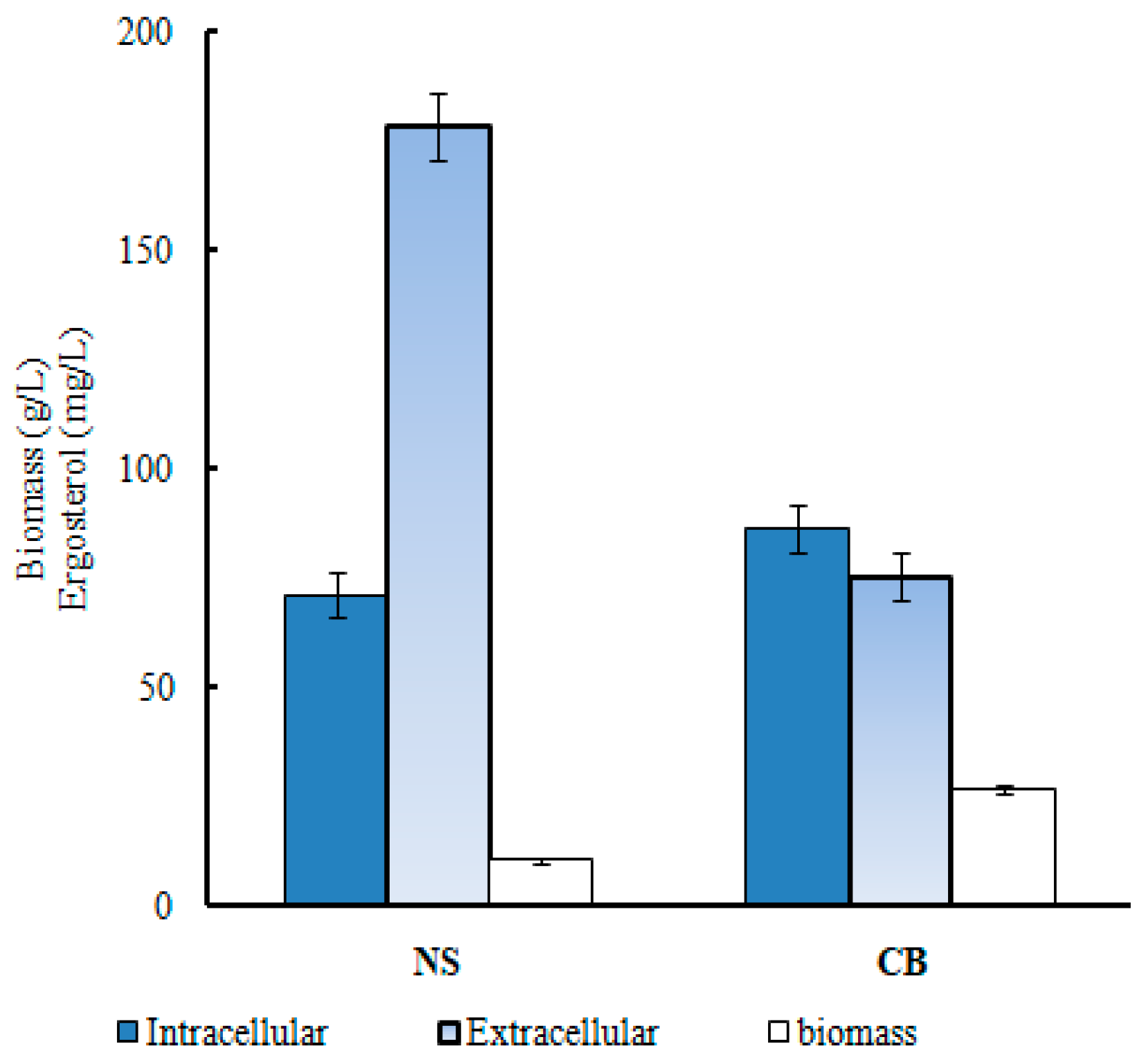

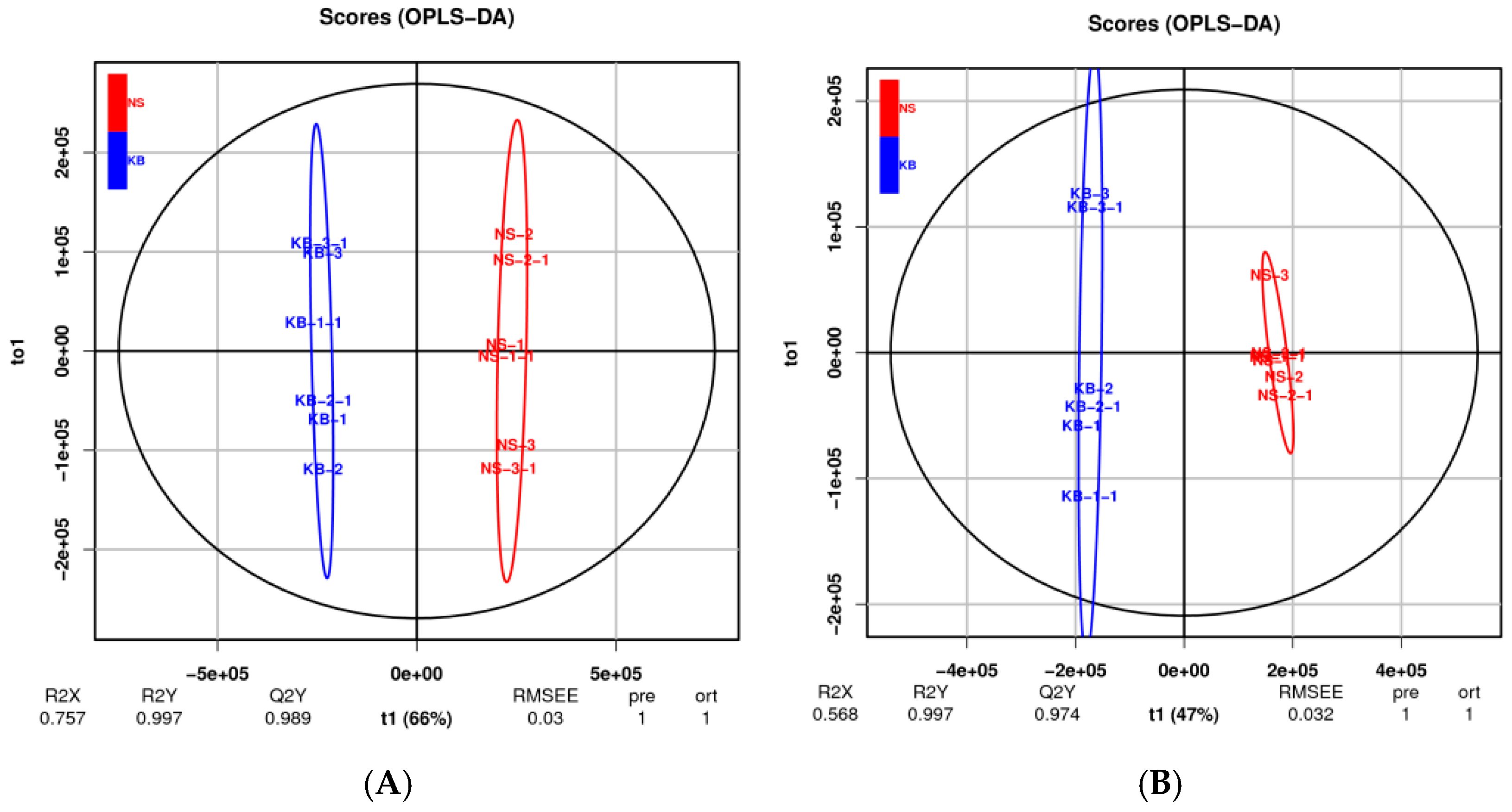
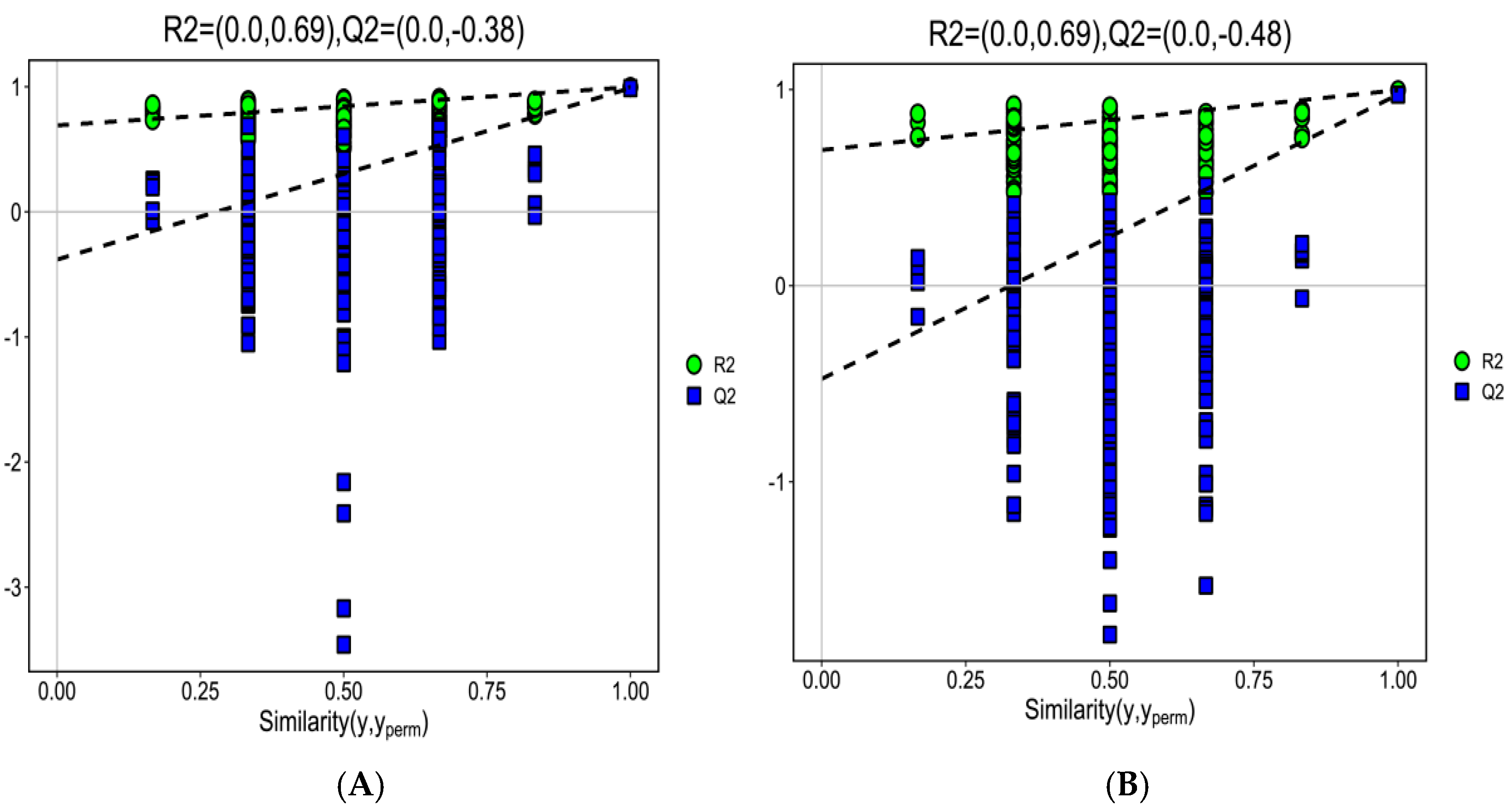

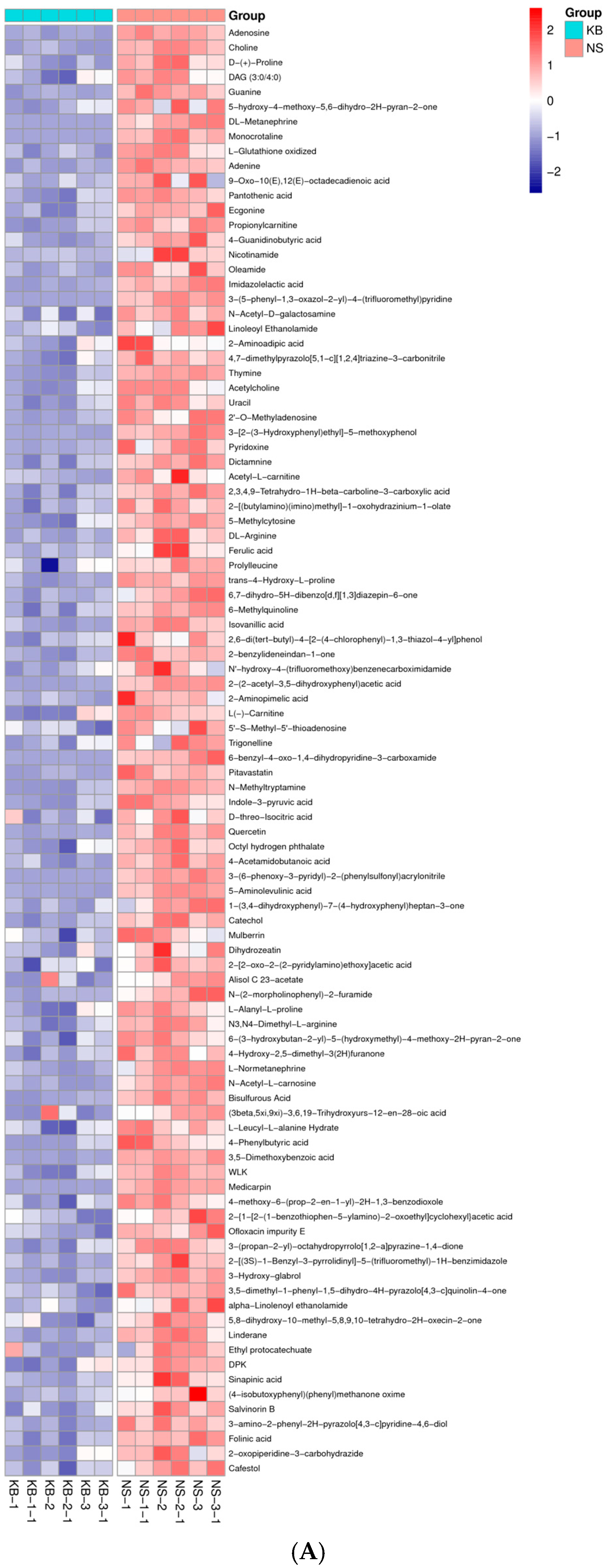
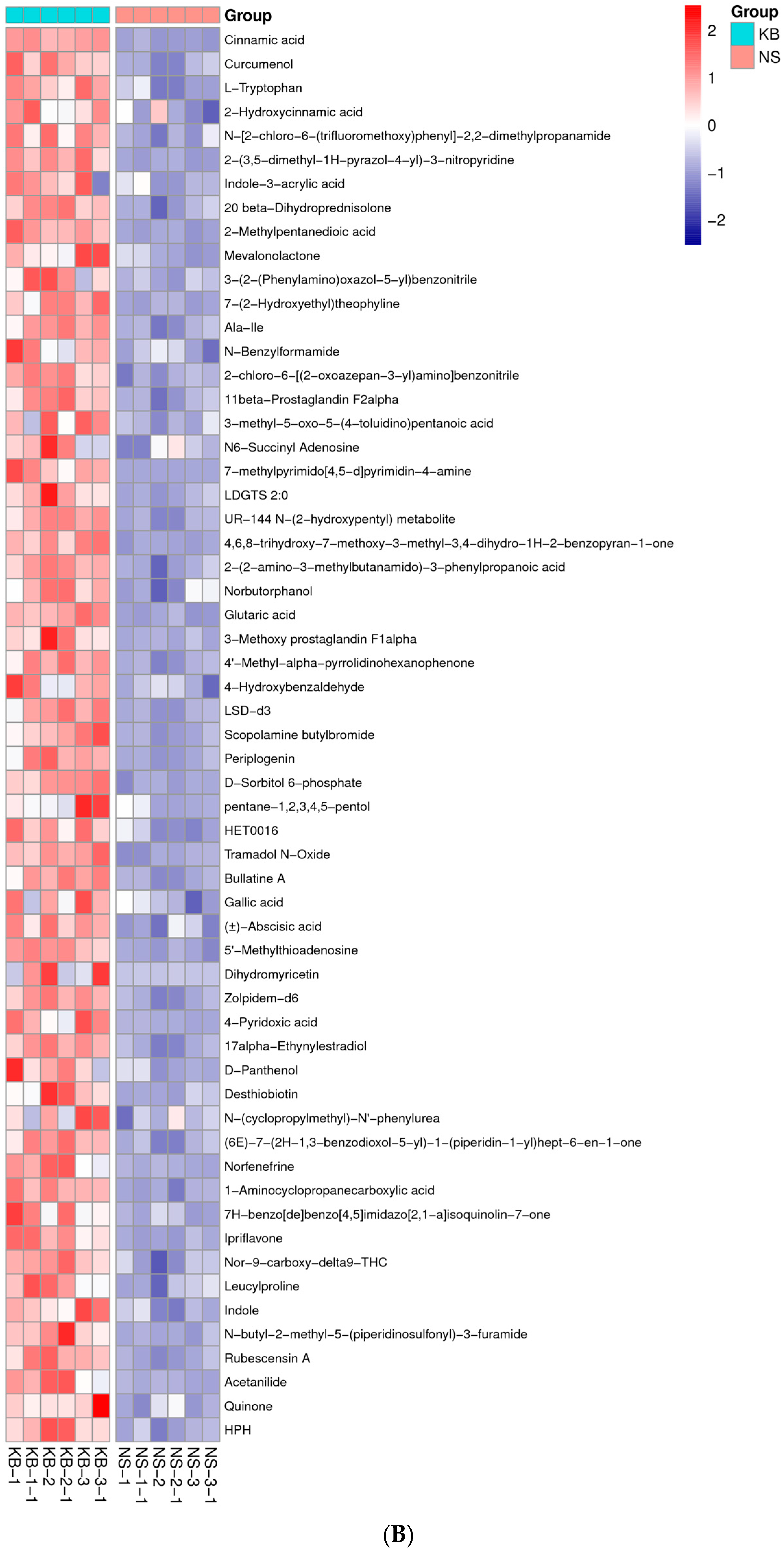

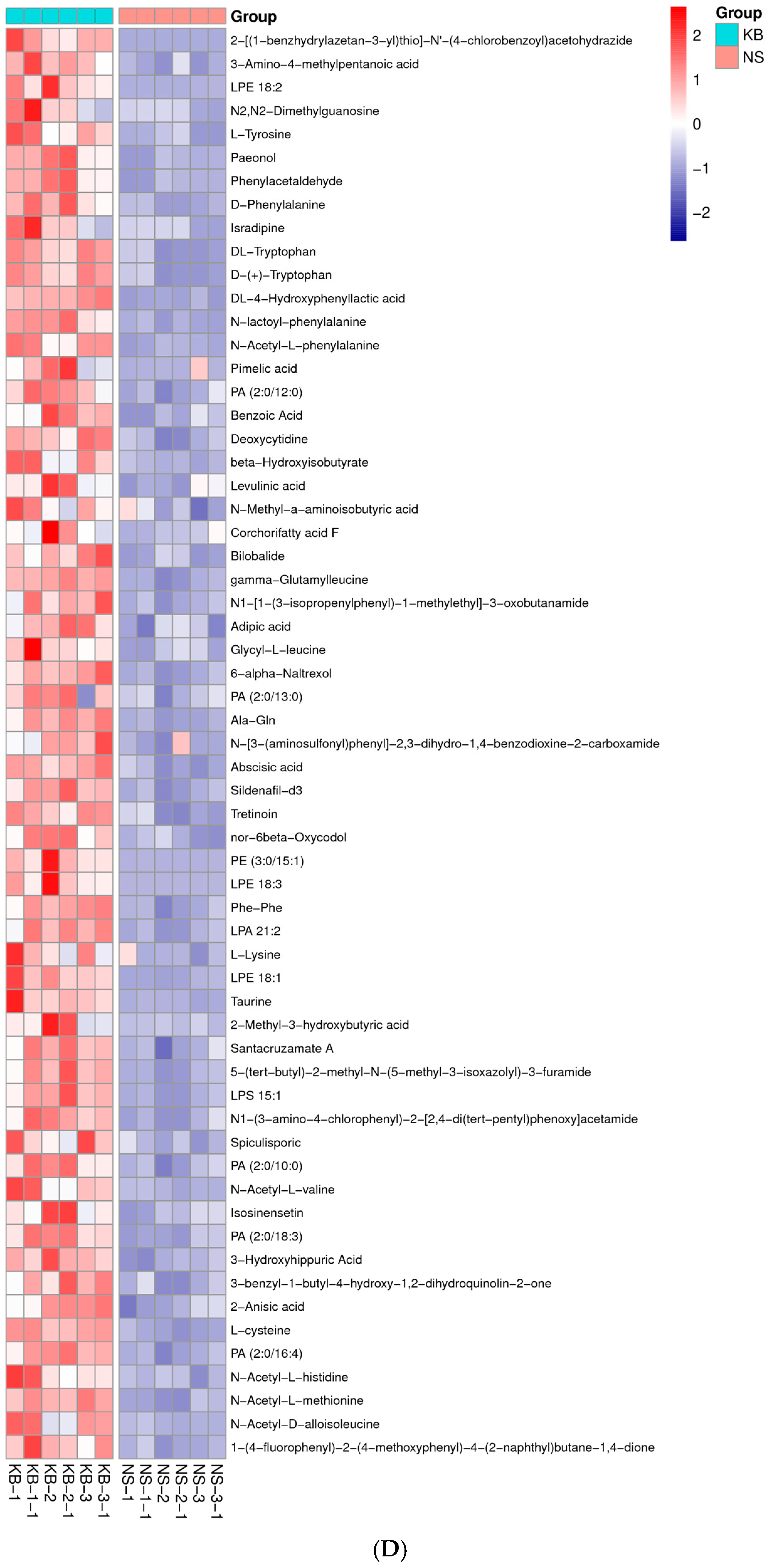

Disclaimer/Publisher’s Note: The statements, opinions and data contained in all publications are solely those of the individual author(s) and contributor(s) and not of MDPI and/or the editor(s). MDPI and/or the editor(s) disclaim responsibility for any injury to people or property resulting from any ideas, methods, instructions or products referred to in the content. |
© 2025 by the authors. Licensee MDPI, Basel, Switzerland. This article is an open access article distributed under the terms and conditions of the Creative Commons Attribution (CC BY) license (https://creativecommons.org/licenses/by/4.0/).
Share and Cite
Wang, M.; Zhang, Z.; Shi, F.; Wu, W. Application of UHPLC-ESI-MS/MS-Based Metabonomic Techniques to Analyze the Cordyceps cicadae Metabolic Profile Changes to the CO(NH2)2 Response Mechanism in the Process of Ergosterol Synthesis. Fermentation 2025, 11, 90. https://doi.org/10.3390/fermentation11020090
Wang M, Zhang Z, Shi F, Wu W. Application of UHPLC-ESI-MS/MS-Based Metabonomic Techniques to Analyze the Cordyceps cicadae Metabolic Profile Changes to the CO(NH2)2 Response Mechanism in the Process of Ergosterol Synthesis. Fermentation. 2025; 11(2):90. https://doi.org/10.3390/fermentation11020090
Chicago/Turabian StyleWang, Miaomiao, Zhicai Zhang, Fenghui Shi, and Weijie Wu. 2025. "Application of UHPLC-ESI-MS/MS-Based Metabonomic Techniques to Analyze the Cordyceps cicadae Metabolic Profile Changes to the CO(NH2)2 Response Mechanism in the Process of Ergosterol Synthesis" Fermentation 11, no. 2: 90. https://doi.org/10.3390/fermentation11020090
APA StyleWang, M., Zhang, Z., Shi, F., & Wu, W. (2025). Application of UHPLC-ESI-MS/MS-Based Metabonomic Techniques to Analyze the Cordyceps cicadae Metabolic Profile Changes to the CO(NH2)2 Response Mechanism in the Process of Ergosterol Synthesis. Fermentation, 11(2), 90. https://doi.org/10.3390/fermentation11020090





